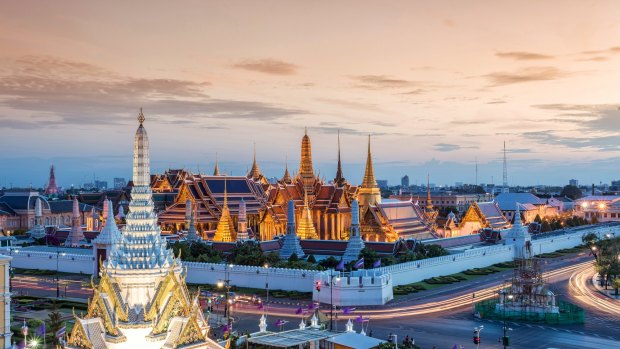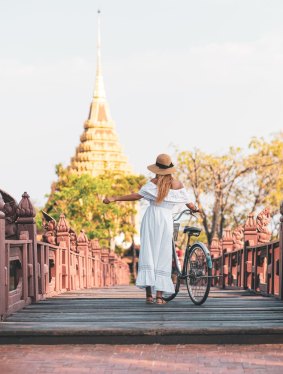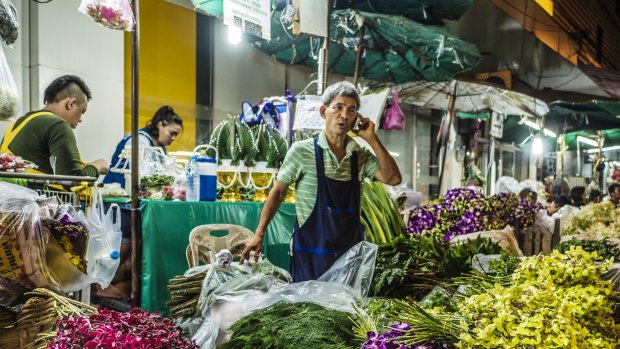This was published 4 years ago
It's time to bypass the beach to discover Thailand's rich and diverse culture
By Danielle Norton

The Grand Palace and Wat Phra Kaew in Bangkok.Credit: Getty Images
Helmet perched jauntily on my head, I squint into the sun and hope for the best. I am about to tackle Bangkok by bike. As I round a corner into the first narrow lane, I lose my balance, drifting perilously close to an open coal barbecue, a brush with disaster that leaves me hooting with laughter. The others in our Urban Adventures tour group seem very confident, but for me each speed hump is as literal as it is figurative. Before long, however, I am swanning along like the rest of them.
The tour takes us from Banglamphu on the Khao San Road side of Bangkok, over the Chao Phraya River via the Rama VIII Bridge to explore Thonburi, the "Brooklyn" of Bangkok. We cycle through villages, along alleyways and across narrow bridges.
"The people of Thailand live their life by the river," says Jay, our guide,

Exploring Thailand by bike.Credit: Kiszon Pascal
as we glide along saying "sawatdee ka" ("hello") to people navigating the same paths. This village life exists just beyond the busy streets but is rarely seen by tourists. The ride takes us to Wat Arun, the Temple of Dawn, and then past the Grand Palace, where we battle the traffic as we head for home.
Later, needing to walk out the aches and pains of the 20-kilometre bike ride, we join the New York Times Hidden History and Food Culture tour. We visit the Museum of Siam, which explores the nation's concept of "Thai-ness". Afterwards, we zoom through the city streets by tuk-tuk, stopping regularly at street stalls for light crispy pancakes, "siri salapao" (Chinese steamed buns) and "patongo" (fried bread) with pandan dip.
Sated, we visit Wat Mahathat Yuwaratrangsarit, a temple with a dedicated area for tourists to meet with monks. Our monk gives a speech about controlling our "monkey minds", cultivating kindness and mindfulness. He explains the five basic precepts of Buddhism: no stealing, lying, killing, cheating, or taking drugs or alcohol.

The Pak Khlong Talat flower market.Credit: Getty Images
Our local guide, a former pop star who now goes by the name of "A", challenges us to remember the official name of Bangkok: Krung Thep Mahanakhon Amon Rattanakosin Mahinthara Ayuthaya Mahadilok Phop Noppharat Ratchathani Burirom Udomratchaniwet Mahasathan Amon Piman Awatan Sathit Sakkathattiya Witsanukam Prasit. He promises free drinks at the Tep Bar in the Hua Lamphong hipster district for anyone who can recite it. Of course we can't, so we pay for our own cocktails.
Never one to shy away from a culinary adventure, I enrol in a cooking class with Dwight Turner at Courageous Kitchen. Turner started this non-profit organisation to help some of the 200,000 urban refugees in Thailand. His cooking school teaches English, as well as practical skills, and Turner assists his employees with their applications for refugee status and resettlement.
Despite being brought to tears by the stories of two young women who support their extended families by working here, I roll up my sleeves and make kratong tong, a delicate entree of thin tapioca-flour batter, cooked in a wok with hot oil, then filled with a mushroom and tofu mixture.
Later in the evening I strap in for a street-food tour with Bangkok local Pam. She walks us through the vibrant Pak Khlong Talat flower market and on to Ban Mo. Once famous for its Burmese pottery, then jewellery, this is now the electronics area of town and groups of men fix TV screens at roadside stalls.
We eat wontons, noodles and omelettes before arriving at Wat Pho, home of the 46-metre-long Reclining Buddha. Silent and cool at night, the 99 pagodas are lit up and I'm captivated by their ethereal beauty.
The next morning I fly to Chiang Mai, the walled city built by King Phaya Mengrai in 1296. After the frenetic vibe of Bangkok, it's a relief to arrive in the north and see verdant hills and open space instead of a spider's web of black wires strung across city streets.
By the time we arrive at Wat Sri Soda early the next morning for a culture and mindfulness tour, dozens of monks are walking together in small groups, carrying offering bowls. Monks are not allowed to prepare their own food and rely on the generosity of their communities in order to eat. We purchase breakfast kits from a nearby stall and place sweet corn, water, pandan biscuits and noodles into their silver bowls.
After the blessing, we wander the temple complex to Wat Umong, the forest temple, before returning to town to visit Wat Suan Dok, the flower temple, with Phra KK, an English-speaking monk who offers "monk chats" for tourists. His own story is a sad one – orphaned as a young boy, he entered the monastery at 12, but has practised acceptance since that time. As he leads our group in meditation, we slip into peaceful stillness.
Discovering locals' secret haunts and favourite places is a unique way to explore a country, and I return home with an expanded palate and an inspired mind. Seeing a city with a guide instead of a guidebook was enlightening. No beach required.
The writer was a guest of Urban Adventures and the Tourism Authority of Thailand.
This article appears in Sunday Life magazine within the Sun-Herald and the Sunday Age on sale February 2.
Sign up for the Traveller Deals newsletter
Get exclusive travel deals delivered straight to your inbox. Sign up now.